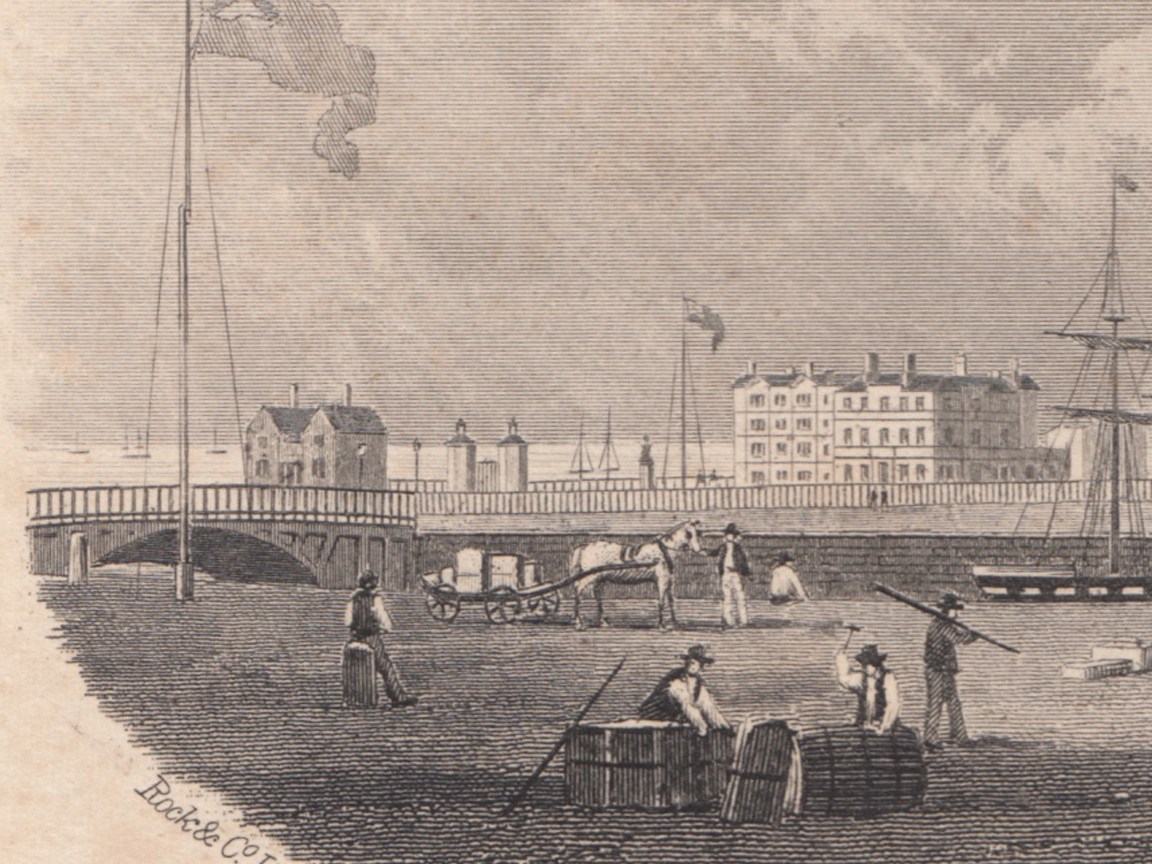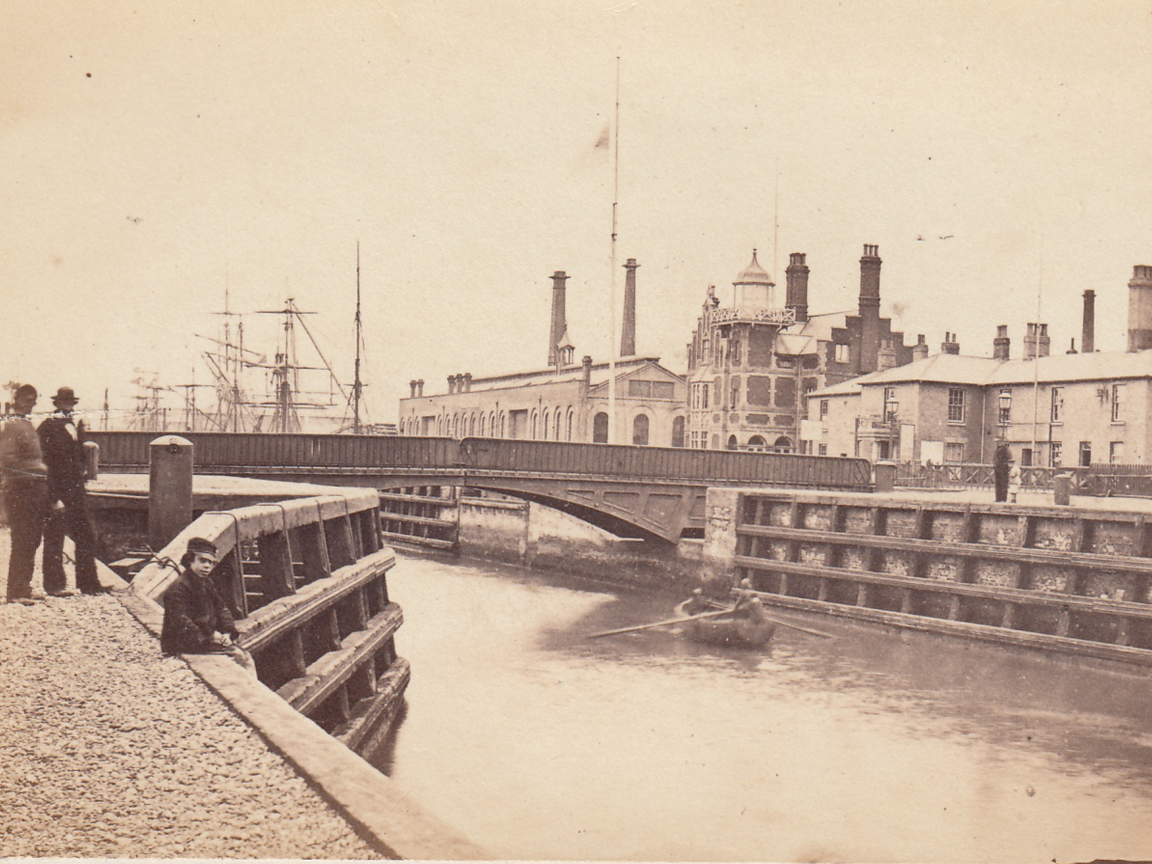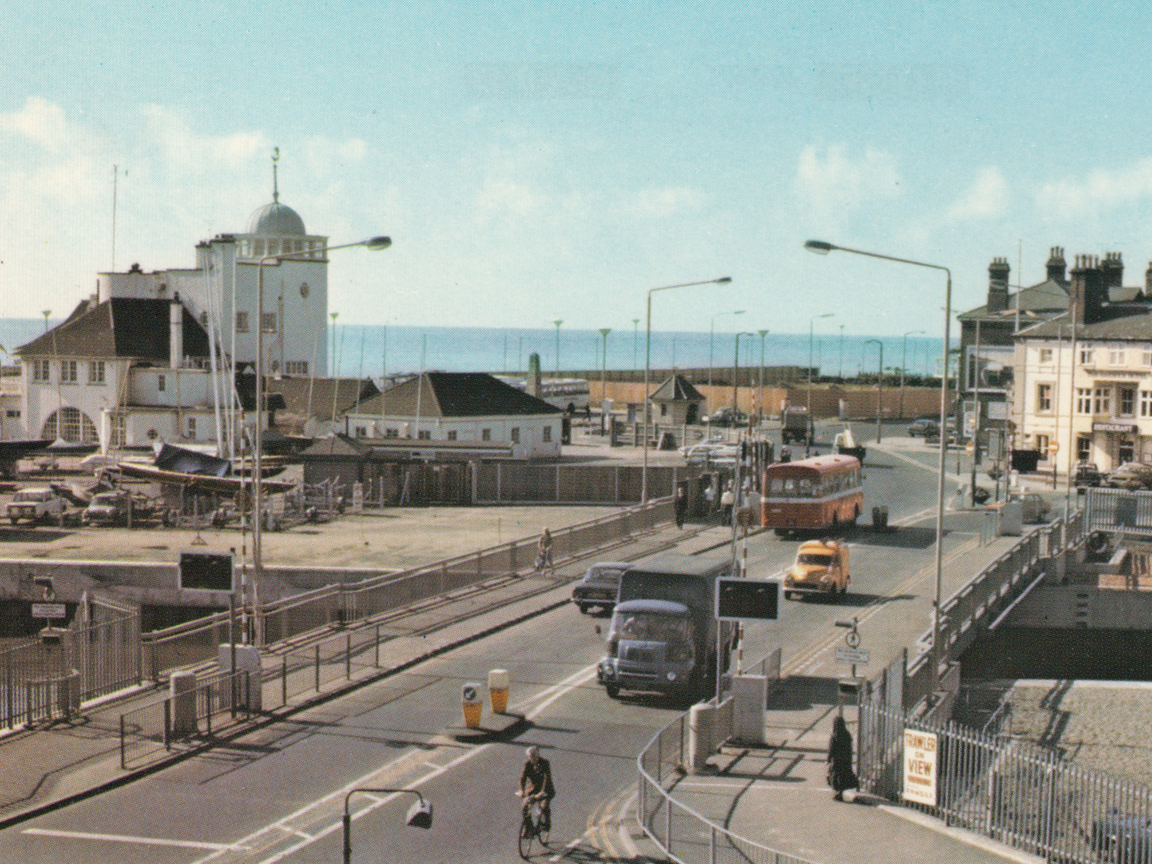



At first there was no bridge, because there was no need for one. No, the good people of Kirkley didn't simply ignore the fine merchants of Lowestoft on the other side of Lake Lothing. There was no "other side". Back then, you could walk from Kirkley to High Street without crossing any water deeper than a puddle. Today, most people in Lowestoft don't know that the cut from the sea to Lake Lothing is not a natural passage, but a man-made canal.
For centuries the only way to get to Lowestoft by land was over the Mutford Bridge.
The connection between Lake Lothing and the sea was intermittent and that's why the major road, all the way back to before the Romans, wandered down the coast from Yarmouth and cuts around Lowestoft, passing over the Mutford Bridge to Beccles. Lake Lothing started as a damp fresh-water pond that was gradually deepened and enlarged as early men cut peat from the ancient bog. The connection it had to the sea depended on weather, tides and currents, which meant that the land between Lake Lothing and the sea was either too wet to lay a road over or too dry to float a boat.
The Romans probably marched over a very early version of the Mutford Bridge as they traveled from the major Roman fort in Colchester to their outposts in Caister and Burgh. Ancient Lowestoft, situated on a high cliff surrounded by undrained swamp and the sea, was as close to being an island as it is possible to be.
Over the years, Lowestoft occasionally tried to make the area between Lake Lothing and the sea one thing or the other. There were attempts in the 17th century (about 1652) to construct a breakwater to prevent the sea from encroaching at all and thereby providing a dry crossing. That didn't work, and the sea pushed back. By 1712 there was a shallow canal that a man in boots could walk through. There were various attempts at building barriers and dunes to keep out the sea and, with depressing regularity, they were breached.
But the sea only needs to beat us up 5 or 6 times before we start to listen to her and by the 19th C. the idea of building a proper canal began to percolate into the public consciousness.
In 1814 a Mr. Cubitt, a local county surveyor, was charged with looking into the matter of building a canal that would eventually link up to Norwich and could handle a ship drawing 8 feet of water. Seven years later, in 1821, he finally published his report, thereby establishing a two century tradition that last until this day of consultants taking inordinate amounts of time and money to publish reports about Lowestoft infrastructure.
While there have been canals in England since Roman times, they really began to take off during the Industrial Revolution, and Norwich was not at all unusual in their enthusiasm for the project.
Mr. Cubitt thought a canal was a fine idea and estimated the cost at £87,000. To get a feel for what this amount meant, at this time the fictional Mr. Darcy in Pride and Prejudice was very, very wealthy with an income of £10,000 a year. Or, in another way, that is almost exactly the amount in 2016 pounds that it is going to cost to build a new central crossing.
Despite the usual vigorous opposition from Great Yarmouth to anything of benefit to Lowestoft, as well as the opposition of a man who had property on the proposed route (there were NIMBYs even back in 1827), the Norwich and Lowestoft Navigation Act passed both Houses of Parliament in 1827 on the 28th of May and the paperwork completed on the 3rd of July, 1827.
Construction started in 1828 by and was managed by the wonderfully named Jabez Bailey. He built a dredger by Lake Lothing and brilliantly named it the "Excavator" and launched it on the 18th of December, 1828.
"Excavator" did its work and in 1830 a canal network called the Haddiscoe Cut was completed up to Lake Lothing and by 1831 ships could sail from Amsterdam or London and reach Norwich.
The Harbour Bridge was opened for traffic on the 9th of June, 1830 and the harbour itself opened to shipping on the 27th of May, 1831. I don't know when the first Lowestoft Bridge traffic jam happened, but I estimate it was 10th of June, 1830.
The bridge was obsolete the minute it opened
It was a static bridge and the width between the piers was narrow so as wide steam ships became the norm, it didn't allow the larger ships passage to the newly opened Lake Lothing. There were also locks between the sea and the lake, but they were abandoned early on as the water level of Lake Lothing rose to match sea level.
The day the canal was finished was a landmark day for Lowestoft. When the last construction weir was pulled back and the sea encroached, no one knew what would happen and it was quite a surprise to see the sea water rushing up to Lake Lothing, where the water level permanently settled at a much higher level. The salt water killed vast numbers of fresh water fish, weird yeast-like froths boiled on surface, and it glowed at night. There stories were told of the salt and fresh water fish fighting to the death as they feasted on each other. Before the cut, Lake Lothing was a fresh body of water, in just a few days it turned into a salt water inlet.
The first owners of the canal ran into money problems and were soon bailed out by the Government. Some things never change. In 1842, the Exchequer sold the canal to a company of Lowestoft men, who sunk more money into it, found themselves into even more trouble and who were then bought out by Samuel Morton Peto, a sharp-eye engineer and entrepreneur who knew a bargain when he saw one. He was 33 at the time.
Peto saw the vast potential of the brand-new transportation technology called the railroad and built an international career around huge infrastructure projects involving rail, sewers, ports and everything that tied them all together. Of course, any railroad needs to have a goal, a place to go to, so by buying the canal and harbour he was able to build it up and promote Lowestoft as a railhead, for both industry and tourism. Although Lowestoft was just one small part of his world-wide construction empire, he made his home here and build a massive hall on the outskirts in Somerleyton, conveniently near the railroad, of course. The many construction projects he started in town were of very high quality, in part, I think, because he made his home here.
The Mr. Peto's railway came to Lowestoft in 1846 and was part of a package of improvements that included important harbour construction. The infrastructure additions and improvements included piers and sheltered inner harbours, and of course, a bridge. Connecting the two sides of the canal was of vital importance to local industry and to reconnect the two parts of town, as well as enhancing Peto's tourism and real estate investments in the Kirkley area. It was such a natural thing that no one even mentions it. I can't find any record of the day it opened, but I'll keep looking.
Once there was a firm connection between the two halves of the town, Kirkley and Pakefield grew at breakneck speed. Terraces, both posh and poor, popped up like mushrooms in former farmer's fields. Factories and maritime and fishing industry support (barrel makers, grain millers, net makers, shipwrights, etc.) lined both sides of the canal. The fanciest shops were along London Road South, in Kirkley, near the grand houses that were being built along the seafront.
As the port grew, the stone bridge became more and more of a nuisance, since it blocked the use of prime potential quays further up towards Lake Lothing by larger ships. The first Swing Bridge solved that problem and was was built with early iron-bridge technology and it eventually wore out. A new bridge was needed and the second swing bridge opened in 1897. The canal was widened and the new bridge was built to span it. It was 116' long and 22 1/2' wide and weighed of 16 tons.
It was obsolete the day it was opened.
Even in 1897, people of Lowestoft understood the need for another crossing further west and the placement of a new third crossing was under constant discussion. Unfortunately, big projects like bridges take a lot of money and a lot of planning. In accordance with tradition established by the esteemed Mr. Cubitt, planning a new bridge was a decades long endeavor and by the time the town felt a new bridge project was possible, another task took precedence- World War One.
World War One was a disaster for everyone and Lowestoft was hit hard. The fishing industry simply disappeared because of the danger from mines and German U-boats as well as the confiscation of the best ships by the government to add to the Royal Navy and the War effort. Tourism, the other main income for the town, stopped. The town was bombed, adding to the general sense of fear and panic. These catastrophes plunged the town into a depression and all thoughts of major public works projects were put on the back burner. No one wanted to start a new bridge. They had other problems to worry about.
Once the War was over, a sense of optimism crept back into Lowestoft, but between the worldwide Depression and recovering from the Great War, the local industries never could bounce back to their former glory. Oh, there were still masses of ships leaving every day to chase the herring, but not like before. Tourism came back, but it had changed. The guest houses lost in the War raids never came back. Richer tourists began to find other places to holiday as car travel became more and more available and the upmarket Edwardian tourist industry became more and more working class. There were still loads of tourists, but not as much money flowed into the town. Another new bridge was needed, everyone knew that, but bridges take a long time to plan and there was no money...
... and then we entered WW2.
[A Yesterday and Today comparison of the Bridge]
As far as a new bridge was concerned WW2 meant same song, different singer. Again, port and infrastructure improvements simply could not be considered- no matter how obviously needed- when the country, including Lowestoft, was being bombed and the fishing and tourist industry ceased to exist. The Parliament and the War Office weren't at all interested in promoting another route for the Nazis to use on march to London, thank you very much, and Lowestoft was on the wrong side of the defensive line the War Office had mapped out in case of invasion. Improving infrastructure was not a priority.
After the war, we had austerity and what money was available went to reconstruct major cities and Europe. Small towns like Lowestoft simply had to fend for themselves. Lowestoft was unlucky again in that it was too large to escape German bombardment and major War depredations, but was too small and insignificant to merit a proportional share of reconstruction monies. With a nation bankrupt and reeling from yet another World War, and the housing needs of the time so very desperate, a new bridge was just not in the cards.
But nonetheless everyone agreed we needed a third crossing.
In the meantime, the swing bridge had survived two world wars and was on its last legs. If Lowestoft didn't watch out, it would lose what little it had. The matter of a new bridge was brought up in the House of Commons in 1957 and again in 1963. The reasons to build a new bridge were exactly the same as they were in 1897 and exactly the same they are today; "The bridge is a bottleneck", "the traffic is horrible and discourages trade and tourism", etc. etc.
The Swing Bridge was demolished in April of 1970. For two years Lowestoft suffered through a ferry at the crossing and in March of 1972 the new Bascule Bridge was officially opened.
It was obsolete the next day.
The present Bascule Bridge was lowered into position during the weekend of 18th-19th December 1971. The bridge itself opened to traffic on Monday 20th March 1972 and was officially opened on Friday 24th March 1972.
With the new bridge's construction, the width of the canal was increased and the new bridge had an expected lifespan of 30 years. The width of the road itself was increased to three lanes, which help traffic flow...a little, but the overall positive impact on traffic flow was very small. We had a new bridge, but we still had the old problems that came with inadequate infrastructure for a town that was now approaching 45,000 inhabitants.
The Bascule Bridge has held up rather well, considering the extremely heavy use it gets and the fact that today it's well passed its sell-by date. While its expected lifespan was only 30 years, the poor thing staggered on and didn't get a major overhaul until 2008, when the Highways Agency spent £2.3m carrying out refurbishments.
The refurbishments didn't go as well as expected. There have been accusations of mismanagement and bad engineering. Whether that is true or not, I don't know, but in 2011 alone there were 21 overnight closures of the bridge, according to Highways Agency figures. Between the refurbishment in 2008 and 2012 the bridge was closed on an average of one month out of the year. Thirty days every year the bridge would either refuse to raise or close, throwing the town and the port into chaos. While the fishing industry is a weak shadow of its former glory attempts to bring new industry into town has been discouraging, and we can lay a good part of that to inadequate infrastructure. With all of Lowestoft's obvious advantages, it's hard to convince new industry to come in a town that is still operating under exactly the same infrastructure that it had in 1842.
Now we have a new bridge on the drawing board and money has been put aside to build a third crossing, we hope starting by 2019-20. If we're lucky that will happen. I'm optimistic. Fingers crossed that the third bridge Lowestoft so desperately needs will be built.
If we're even luckier, it won't be obsolete the minute it's built.
Watch this space.


Do you have Lowestoft-interest photos to add to the database or want to contribute an article? Or do you have a correction or comment? More information about adding to the site is here.

Events, clubs and Lowestoft news of interest to history buffs are updated here. Do you have an event or club you want posted? Let us know!

Find out what's new on the site. New images and commentary are uploaded and updated daily.